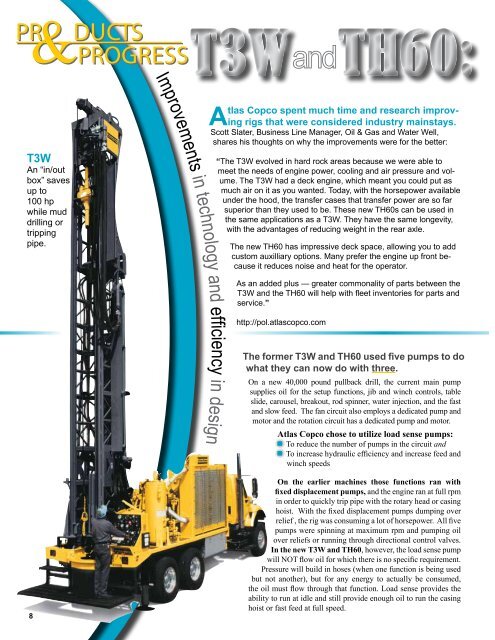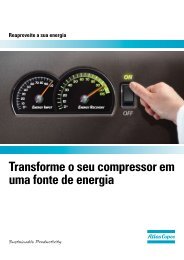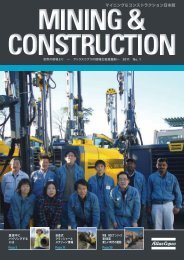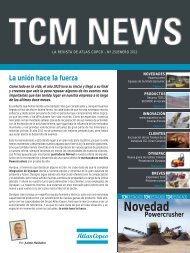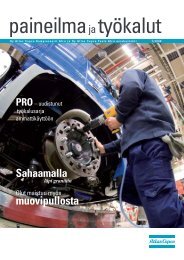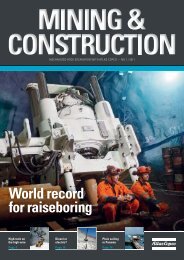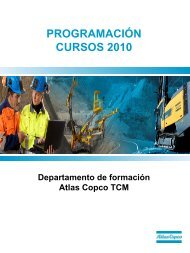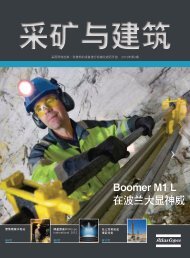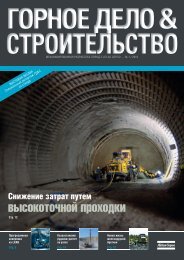atlas CopCo Center of exCellenCe sets itself apart for water well ...
atlas CopCo Center of exCellenCe sets itself apart for water well ...
atlas CopCo Center of exCellenCe sets itself apart for water well ...
You also want an ePaper? Increase the reach of your titles
YUMPU automatically turns print PDFs into web optimized ePapers that Google loves.
PR DUCTS<br />
PROGRESS<br />
t3w<br />
An “in/out<br />
box” saves<br />
up to<br />
100 hp<br />
while mud<br />
drilling or<br />
tripping<br />
pipe.<br />
88<br />
improvements in technology and effi ciency in design<br />
T3W TH60:<br />
<strong>atlas</strong> Copco spent much time and research improving<br />
rigs that were considered industry mainstays.<br />
Scott Slater, Business Line Manager, oil & Gas and Water Well,<br />
shares his thoughts on why the improvements were <strong>for</strong> the better:<br />
“The T3W evolved in hard rock areas because we were able to<br />
meet the needs <strong>of</strong> engine power, cooling and air pressure and volume.<br />
The T3W had a deck engine, which meant you could put as<br />
much air on it as you wanted. Today, with the horsepower available<br />
under the hood, the transfer cases that transfer power are so far<br />
superior than they used to be. These new TH60s can be used in<br />
the same applications as a T3W. They have the same longevity,<br />
with the advantages <strong>of</strong> reducing weight in the rear axle.<br />
The new TH60 has impressive deck space, allowing you to add<br />
custom auxilliary options. Many prefer the engine up front because<br />
it reduces noise and heat <strong>for</strong> the operator.<br />
As an added plus — greater commonality <strong>of</strong> parts between the<br />
T3W and the TH60 will help with fleet inventories <strong>for</strong> parts and<br />
service.”<br />
http://pol.<strong>atlas</strong>copco.com<br />
the <strong>for</strong>mer t3w and th60 used five pumps to do<br />
what they can now do with three.<br />
On a new 40,000 pound pullback drill, the current main pump<br />
supplies oil <strong>for</strong> the setup functions, jib and winch controls, table<br />
slide, carousel, breakout, rod spinner, <strong>water</strong> injection, and the fast<br />
and slow feed. The fan circuit also employs a dedicated pump and<br />
motor and the rotation circuit has a dedicated pump and motor.<br />
<strong>atlas</strong> Copco chose to utilize load sense pumps:<br />
•<br />
To reduce the number <strong>of</strong> pumps in the circuit and<br />
•<br />
To increase hydraulic efficiency and increase feed and<br />
winch speeds<br />
on the earlier machines those functions ran with<br />
fixed displacement pumps, and the engine ran at full rpm<br />
in order to quickly trip pipe with the rotary head or casing<br />
hoist. With the fixed displacement pumps dumping over<br />
relief , the rig was consuming a lot <strong>of</strong> horsepower. All five<br />
pumps were spinning at maximum rpm and pumping oil<br />
over reliefs or running through directional control valves.<br />
in the new t3W and tH60, however, the load sense pump<br />
will NOT flow oil <strong>for</strong> which there is no specific requirement.<br />
Pressure will build in hoses (when one function is being used<br />
but not another), but <strong>for</strong> any energy to actually be consumed,<br />
the oil must flow through that function. Load sense provides the<br />
ability to run at idle and still provide enough oil to run the casing<br />
hoist or fast feed at full speed.


